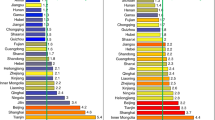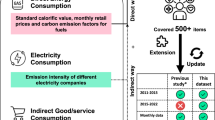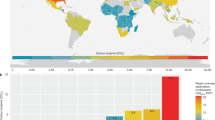Abstract
Households’ carbon footprints are unequally distributed among the rich and poor due to differences in the scale and patterns of consumption. We present distributional focused carbon footprints for Chinese households and use a carbon-footprint-Gini coefficient to quantify inequalities. We find that in 2012 the urban very rich, comprising 5% of population, induced 19% of the total carbon footprint from household consumption in China, with 6.4 tCO2/cap. The average Chinese household footprint remains comparatively low (1.7 tCO2/cap), while those of the rural population and urban poor, comprising 58% of population, are 0.5–1.6 tCO2/cap. Between 2007 and 2012 the total footprint from households increased by 19%, with 75% of the increase due to growing consumption of the urban middle class and the rich. This suggests that a transformation of Chinese lifestyles away from the current trajectory of carbon-intensive consumption patterns requires policy interventions to improve living standards and encourage sustainable consumption.
This is a preview of subscription content, access via your institution
Access options
Subscribe to this journal
Receive 12 print issues and online access
$209.00 per year
only $17.42 per issue
Buy this article
- Purchase on Springer Link
- Instant access to full article PDF
Prices may be subject to local taxes which are calculated during checkout



Similar content being viewed by others
References
Friedlingstein, P. et al. Persistent growth of CO2 emissions and implications for reaching climate targets. Nat. Geosci. 7, 709–715 (2014).
Carson, R. T. The environmental kuznets curve: seeking empirical regularity and theoretical structure. Rev. Environ. Econ. Policy 4, 3–23 (2010).
Liu, Z. et al. Targeted opportunities to address the climate–trade dilemma in China. Nat. Clim. Change 6, 201–206 (2015).
Hoekstra, A. Y. & Wiedmann, T. O. Humanity’s unsustainable environmental footprint. Science 344, 1114–1117 (2014).
Feng, K. & Hubacek, K. Carbon implications of China’s urbanization. Energy Ecol. Environ. 1, 39–44 (2016).
Ottelin, J., Heinonen, J. & Junnila, S. New energy efficient housing has reduced carbon footprints in outer but not in inner urban areas. Environ. Sci. Technol. 49, 9574–9583 (2015).
Wiedenhofer, D., Lenzen, M. & Steinberger, J. K. Energy requirements of consumption: urban form, climatic and socio-economic factors, rebounds and their policy implications. Energy Policy 63, 696–707 (2013).
Liu, L.-C., Wu, G., Wang, J.-N. & Wei, Y.-M. China’s carbon emissions from urban and rural households during 1992–2007. J. Clean. Prod. 19, 1754–1762 (2011).
Chakravarty, S. et al. Sharing global CO2 emission reductions among one billion high emitters. Proc. Natl Acad. Sci. USA 106, 11884–11888 (2009).
Chancel, L. & Piketty, T. Carbon and Inequality: From Kyoto to Paris (PSE, 2015).
Di Giulio, A. & Fuchs, D. Sustainable consumption corridors: concept, objections, and responses. GAIA 23, 184–192 (2014).
Grubler, A. & Pachauri, S. Problems with burden-sharing proposal among one billion high emitters. Proc. Natl Acad. Sci. USA 106, E122–E123 (2009).
Jackson, R. B. et al. Reaching peak emissions. Nat. Clim. Change 6, 7–10 (2015).
Spangenberg, J. China in the anthropocene: culprit, victim or last best hope for a global ecological civilisation? BioRisk 9, 1–37 (2014).
Peters, G. P., Andrew, R. M., Solomon, S. & Friedlingstein, P. Measuring a fair and ambitious climate agreement using cumulative emissions. Environ. Res. Lett. 10, 105004 (2015).
World Development Indicators (WDI) Database (World Bank, 2016); http://data.worldbank.org/indicator
Xie, Y. & Zhou, X. Income inequality in today’s China. Proc. Natl Acad. Sci. USA 111, 6928–6933 (2014).
Fan, J.-L. et al. Residential carbon emission evolutions in urban–rural divided China: an end-use and behavior analysis. Sustain. Dev. Energy Wat. Environ. Syst. 101, 323–332 (2013).
Zhao, X., Li, N. & Ma, C. Residential energy consumption in urban China: a decomposition analysis. Energy Policy 41, 644–653 (2012).
Golley, J. & Meng, X. Income inequality and carbon dioxide emissions: the case of Chinese urban households. Energy Econ. 34, 1864–1872 (2012).
Knight, J. Inequality in China An Overview (The World Bank, 2013).
Minx, J. C. et al. A ‘Carbonizing Dragon’: China’s fast growing CO2 emissions revisited. Environ. Sci. Technol. 45, 9144–9153 (2011).
Antal, M. & Van Den Bergh, J. C. J. M. Green growth and climate change: conceptual and empirical considerations. Clim. Policy 16, 165–177 (2016).
Liu, Z. et al. Energy policy: a low-carbon road map for China. Nature 500, 143–145 (2013).
Zhang, X., Karplus, V. J., Qi, T., Zhang, D. & He, J. Carbon emissions in China: how far can new efforts bend the curve? Energy Econ. 54, 388–395 (2016).
Akenji, L. Consumer scapegoatism and limits to green consumerism. J. Clean. Prod. 63, 13–23 (2014).
Fuchs, D. et al. Power: the missing element in sustainable consumption and absolute reductions research and action. J. Clean. Prod. 132, 298–307 (2015).
Lorek, S. & Spangenberg, J. H. Sustainable consumption within a sustainable economy—beyond green growth and green economies. J. Clean. Prod. 63, 33–44 (2014).
Groot, L. Carbon Lorenz curves. Resour. Energy Econ. 32, 45–64 (2010).
Teng, F., He, J., Pan, X. & Zhang, C. Metric of carbon equity: carbon Gini Index based on historical cumulative emission per capita. Adv. Clim. Change Res. 2, 134–140 (2011).
Duarte, R., Mainar, A. & Sánchez-Chóliz, J. Social groups and CO2 emissions in Spanish households. Energy Policy 44, 441–450 (2012).
Baiocchi, G., Minx, J. & Hubacek, K. The impact of social factors and consumer behavior on carbon dioxide emissions in the United Kingdom: a regression based on input-output and geodemographic consumer segmentation data. J. Ind. Ecol. 14, 50–72 (2010).
López, L. A., Arce, G., Morenate, M. & Monsalve, F. Assessing the inequality of Spanish households through the carbon footprint: the 21st century great recession effect: inequality and carbon footprint of Spain. J. Ind. Ecol. 20, 571–581 (2016).
Weber, C. L. & Matthews, H. S. Quantifying the global and distributional aspects of American household carbon footprint. Ecol. Econ. 66, 379–391 (2008).
Kerkhof, A. C., Benders, R. M. J. & Moll, H. C. Determinants of variation in household CO2 emissions between and within countries. Energy Policy 37, 1509–1517 (2009).
Xu, X., Han, L. & Lv, X. Household carbon inequality in urban China, its sources and determinants. Ecol. Econ. 128, 77–86 (2016).
Liu, Z. et al. Reduced carbon emission estimates from fossil fuel combustion and cement production in China. Nature 524, 335–338 (2015).
Korsbakken, J. I., Peters, G. P. & Andrew, R. M. Uncertainties around reductions in China’s coal use and CO2 emissions. Nat. Clim. Change 6, 687–690 (2016).
Ottelin, J., Heinonen, J. & Junnila, S. Greenhouse gas emissions from flying can offset the gain from reduced driving in dense urban areas. J. Transp. Geogr. 41, 1–9 (2014).
Girod, B., van Vuuren, D. P. & Hertwich, E. G. Climate policy through changing consumption choices: options and obstacles for reducing greenhouse gas emissions. Glob. Environ. Change 25, 5–15 (2014).
Girod, B., van Vuuren, D. P. & Hertwich, E. G. Global climate targets and future consumption level: an evaluation of the required GHG intensity. Environ. Res. Lett. 8, 14016 (2013).
Hofmann, J., Guan, D., Chalvatzis, K. & Huo, H. Assessment of electrical vehicles as a successful driver for reducing CO2 emissions in China. Appl. Energy http://dx.doi.org/10.1016/j.apenergy.2016.06.042 (2016).
Creutzig, F., Baiocchi, G., Bierkandt, R., Pichler, P.-P. & Seto, K. C. Global typology of urban energy use and potentials for an urbanization mitigation wedge. Proc. Natl Acad. Sci. USA 112, 6283–6288 (2015).
Ramaswami, A., Russell, A. G., Culligan, P. J., Sharma, K. R. & Kumar, E. Meta-principles for developing smart, sustainable, and healthy cities. Science 352, 940–943 (2016).
Steinberger, J. K., Timmons Roberts, J., Peters, G. P. & Baiocchi, G. Pathways of human development and carbon emissions embodied in trade. Nat. Clim. Change 2, 81–85 (2012).
Lamb, W. F. et al. Transitions in pathways of human development and carbon emissions. Environ. Res. Lett. 9, 14011 (2014).
Jorgenson, A. K. & Givens, J. The changing effect of economic development on the consumption-based carbon intensity of well-being, 1990–2008. PLoS ONE 10, e0123920 (2015).
Input-Output Table of China, 2012 and 2007 (National Bureau of Statistics, Statistical Press, 2015).
NBS Energy Statistical Yearbook of China Fourth Revision; 2012 and 2007 (Statistical Press, 2016).
China Urban Life and Price Yearbook 2011 and 2007 (National Bureau of Statistics, Statistical Press, 2012).
Narayanan, B., Aguiar, A. & McDougall, R. Global Trade, Assistance, and Production: The GTAP 9 Data Base (Center for Global Trade Analysis, Purdue University, 2015).
Su, B. & Ang, B. W. Multi-region input–output analysis of CO2 emissions embodied in trade: the feedback effects. Ecol. Econ. 71, 42–53 (2011).
Shan, Y. et al. New provincial CO2 emission inventories in China based on apparent energy consumption data and updated emission factors. Appl. Energy http://dx.doi.org/10.1016/j.apenergy.2016.03.073 (2016).
Acknowledgements
This work was supported by National Key R&D Program of China (2016YFA0602603 and 2016YFA0602604), the National Natural Science Foundation of China (41629501, 71521002, 41461118, 41501605), Austrian National Science funded project ‘MISO—modelling the global metabolic transition’ (P27590), the UK Economic and Social Research Council funded project ‘Dynamics of Green Growth in European and Chinese Cities’ (ES/L016028/1), the UK Natural Environment Research Council funded project ‘Integrated assessment of the emission-health-socioeconomics nexus and air pollution mitigation solutions and interventions in Beijing’ (NE/N00714X/1). Many thanks go to J. Minx, F. Krausmann and J. K. Steinberger for their feedback on the manuscript, to G. Peters for support with the global emissions data set for the GTAP-MRIO and to L. Yu for his feedback on the concordances to bridge the GTAP-MRIO and the Chinese national IOTs classifications.
Author information
Authors and Affiliations
Contributions
D.W. and D.G. designed the research, performed calculations and discussed the results. D.W. wrote the paper. D.G., Z.L., J.M., N.Z. and Y.-M.W. collected data and contributed to writing the paper.
Corresponding authors
Ethics declarations
Competing interests
The authors declare no competing financial interests.
Supplementary information
Supplementary Information
Supplementary Information (PDF 951 kb)
Rights and permissions
About this article
Cite this article
Wiedenhofer, D., Guan, D., Liu, Z. et al. Unequal household carbon footprints in China. Nature Clim Change 7, 75–80 (2017). https://doi.org/10.1038/nclimate3165
Received:
Accepted:
Published:
Issue Date:
DOI: https://doi.org/10.1038/nclimate3165
This article is cited by
-
Underestimations of the income-based ecological footprint inequality
Climatic Change (2024)
-
Generalized anxiety disorder among rural primary and middle school students during the outbreak of COVID-19: a multicenter study in three southern Chinese cities
BMC Public Health (2023)
-
Japanese urban household carbon footprints during early-stage COVID-19 pandemic were consistent with those over the past decade
npj Urban Sustainability (2023)
-
Extension and update of multiscale monthly household carbon footprint in Japan from 2011 to 2022
Scientific Data (2023)
-
A novel city-level carbon emission quota allocation method for carbon peak and neutrality targets
Environment, Development and Sustainability (2023)



